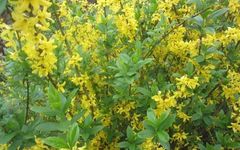Also known as Huang Jin Tiao and Huang Shou Dan, Forsythia is a plant belonging to the Oleaceae family.
【Morphological Characteristics】 A deciduous shrub that can grow up to 3 meters tall. The stems are erect, and the branches have hollow pith. They typically droop slightly and are somewhat four-angled with raised lenticels. The leaves are either simple or trifoliate, opposite, ovate, broadly ovate, or elliptical-ovate, with neat coarse serrations at the base of the leaf margin. The flowers are golden yellow, and the fruit is ovoid in shape.
【Biological Characteristics】 Forsythia prefers sunlight, is tolerant of partial shade, and has low soil requirements, but it grows best in calcareous soil. It is cold-resistant, drought-tolerant, and can thrive in poor soil, but it is sensitive to waterlogging. The root system is well-developed and has strong sprouting ability. It shows considerable resistance to chlorine gas and hydrochloric acid.
【Landscaping Uses】 Forsythia has a beautiful tree form and vigorous growth. It flowers before the leaves in early spring, with a long flowering period and abundant blooms, creating a stunning display of golden flowers that are fragrant and pleasing to the eye. It is an excellent ornamental shrub for early spring and can be used to create hedges, flower beds, and borders. It is widely used in urban greening and beautification, making it a valuable species for ornamental agriculture and modern landscaping.
【Propagation Techniques】 Forsythia can be propagated through cuttings, division, and seeding.
1. Cutting Propagation. Hardwood cuttings should be taken in February to March. Use 1-2 year old branches that have been sand-stored from the previous year, cut into 15-20 cm long cuttings for propagation. Alternatively, during the rainy season, use current year’s woody branches cut into 8-15 cm long cuttings, which have a very high survival rate.
2. Division Propagation. This can be done in both spring and autumn, but autumn is preferable as spring division may affect flowering. After the leaves fall in autumn, dig up the entire plant, divide it into several clumps, each with 2-3 stems and roots, and then replant the clumps with watering. To ensure survival, cut the stems at 20-25 cm to reduce moisture evaporation.
3. Seed Propagation. Forsythia begins to bear fruit at 2-3 years of age. The flowering period is from March to April, and the fruit ripens from August to September. The fruit is green or yellow-brown when mature. When the fruit splits, the seeds can easily scatter. Harvest the seeds promptly, clean them, and store them dry for spring sowing the following year. Soak the seeds in 40°C warm water for 40 minutes before sowing, then use moist sand to germinate them until some seeds crack open and show white. After sowing, cover with 1 cm of soil, and seedlings will emerge in 30-40 days.

